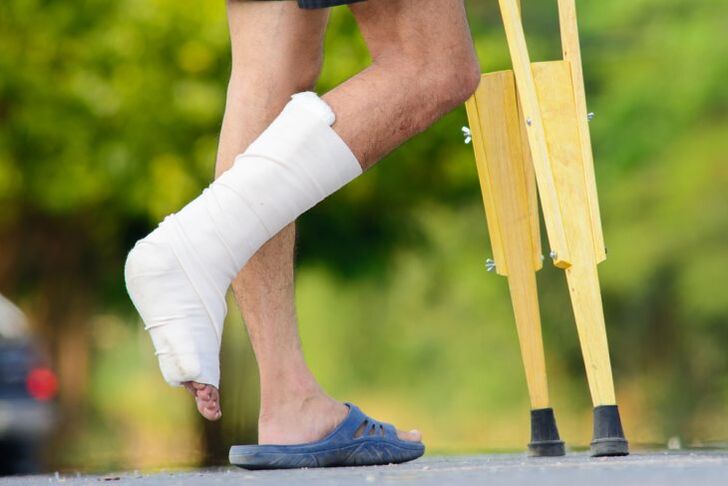Deforming osteoarthritis most often affects the joints of the lower extremities, one of which is the ankle. These joints are highly mobile in different planes and play an important role in walking (turning the foot and transferring body weight from heel to toe), in addition to supporting the weight of the human body. Osteoarthritis of the ankle joint is a kind of retribution for walking upright. But many other factors play a role in the development of the disease. First, imperceptibly for the patient, the softening and thinning of the cartilage lining of the joint begins, then it cracks, which triggers the inflammatory process, the growth of bone tissue in the form of osteophytes. With advanced osteoarthritis, a person cannot move without support and experiences severe pain, especially when leaning on the leg. Disability is possible within a few years after the onset of the disease, if early and comprehensive treatment is not started.
Reasons for the development of the disease

Previous injuries to the ankle joint increase the likelihood that a degenerative process will develop in it.
- Body weight gain;
- Flat feet, congenital foot deformities (horses foot, club foot);
- Metabolic disorders in diseases such as diabetes mellitus, gout, atherosclerosis of the vessels of the legs;
- Past joint injuries, for example, damage to the ligamentous apparatus, fractures of the ankles and foot bones;
- Constant overload of the joint, leading to microtraumatization (in athletes and people who carry heavy loads);
- hereditary predisposition to arthrosis of the joints;
- Previous inflammation of the joint (arthritis) of an infectious nature or with systemic diseases (rheumatoid, psoriatic, gouty arthritis).
Depending on the absence or presence of a specific factor that has caused the disease, ankle osteoarthritis can be primary or secondary. There is also a division into stages. In the presence of the 1st stage, a person can work, if the arthrosis has passed to the 2nd and 3rd stage, pain and limited mobility lead to disability (temporary or complete).
Symptoms of ankle osteoarthritis
- Initial pain. This is one of the first symptoms of osteoarthritis of the ankle joint. Pain appears after prolonged sitting when trying to lean on the leg, it may be accompanied by stiffness of short-term movements in the joint. After taking a few steps, the pain disappears;
- Pain during and after physical exertion;
- Aching night pain is associated with an inflammatory process that is triggered by the destruction of cartilaginous tissue;
- Crunch, clicks in the joint during movement;
- Swelling, especially noticeable below the ankles;
- Restriction of movements;
- Hypotrophy of the periarticular muscles and weakness of the ligamentous apparatus due to the fact that a person begins to avoid the sore leg;
- Joint deformity in the last stage of osteoarthritis.
Diagnostics
It is necessary to distinguish arthrosis and its exacerbation from various inflammatory processes in the joint, for example, as a result of rheumatoid gout or psoriatic arthritis. Therefore, the doctor prescribes a detailed blood test, rheumatoid tests, a CRP test, uric acid. With arthrosis, these indicators are normal, but if the disease is in the acute stage, ESR and leukocytes may increase. To establish the stage of osteoarthritis and obtain more detailed information on the pathology, radiography in 2 projections, ultrasound, CT or MRI of the joint is used. On the x-ray, a slight narrowing of the joint space can be observed if the arthrosis is in the first stage. During the transition to the second stage, the joint space is reduced by 40% or more than normal. And at the third stage, it narrows significantly, it can be practically absent, growths and deformations of the bones are visible.
treatment methods
Osteoarthritis of the ankle joint, as well as other locations, involves complex, long-term and course treatment.
- Unloading of the ankle joint during a period of severe exacerbation (walking with a cane on the side of a healthy limb), the use of a bandage;
- Exclusion of shock loads (jumping, running), vibration, weight transfer, prolonged stay on the legs;
- body weight control;
- Give up smoking;
- Wearing a semi-rigid orthosis with concomitant joint instability;
- Physiotherapy (UHF, SMT, laser therapy, magnetic therapy);
- Medical therapy:
- NSAIDs externally, orally, in injections;
- glucocorticoids together with intraarticular and periarticular anesthetics to relieve inflammation;
- vascular agents;
- muscle relaxants to eliminate spasm of muscle tissue;
- chondroprotectors are more effective drugs administered intra-articularly. If it is not possible to receive intra-articular injections, intramuscular administration is indicated, oral administration;
- hyaluronic acid preparations to restore the quality of synovial fluid.
- Orthopedic insoles, comfortable shoes with a small heel;
- Gymnastics to strengthen the musculoskeletal system. The following exercises should be done daily:
- lying or sitting, bend and unbend your toes 10 times;
- lying or sitting, pull your feet towards you and out 10 times;
- turn feet out and in 10 times;
- make circular movements with the feet clockwise and counterclockwise 10 times;
- sitting on a chair, place your feet on the floor with your toes and heels together, alternate your legs back and forth, repeat 15-20 times.
- Swimming, water aerobics;
- At the third stage of arthrosis and the ineffectiveness of conservative treatment, endoprosthesis replacement of the ankle joint or removal of the destroyed cartilaginous lining and the joint capsule with their closure with the help of a rod structure or the apparatus is indicated. Ilizarov (arthrodesis).
Prevention

To reduce the risk of developing arthrosis, preference should be given to foods rich in protein, and spicy, salty, fried foods and alcohol should be excluded from the diet.
- Avoid joint injuries. To do this, you need to try not to wear shoes with unstable heels, too hard soles, wear special protective equipment when playing sports;
- Control body weight;
- You need to follow a diet, that is, eat more protein-rich foods and refrain from salty, spicy, fried alcohol;
- Timely treat and correct metabolic, endocrine disorders, vascular diseases;
- Perform the above exercises for the ankle joints.
The effectiveness of treatment of deforming arthrosis of the ankle joint depends on the stage of its development and the presence of concomitant diseases. In any case, if conservative therapy is indicated, it should include both medication and physical methods, as well as correction with orthopedic products.
Which doctor to contact
For pain in the ankle joint, you should see a rheumatologist. The doctor will prescribe exercises, medications and identify the cause of the disease. In case of diabetes or gout, it will be useful to visit an endocrinologist, in case of atherosclerosis of the vessels of the lower extremities - a vascular surgeon and a cardiologist. An orthopedist plays an important role in treatment: he will not only help you choose the right shoes, orthopedic insoles, but also perform an operation if necessary. If you are overweight, you should consult a nutritionist and select the appropriate diet. Non-pharmacological treatment is carried out with the participation of a physiotherapist.




























